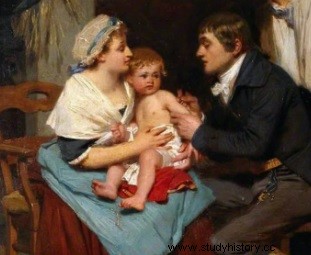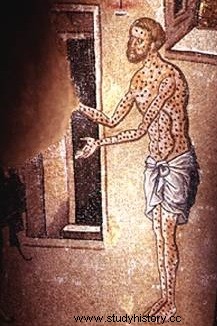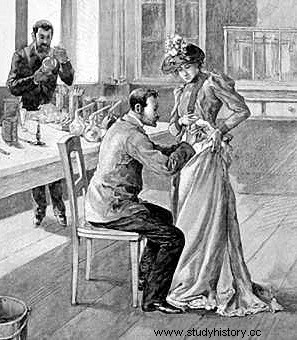 It was at the end of the 18th century that the English Jenner demonstrated the protective effect of the vaccine of cow versus human smallpox. This discovery lays the first foundations of immunology and vaccinations. After variolation practiced empirically from the 17th century in China, then in Constantinople and England, vaccination developed through the work of Edward Jenner and Louis Pasteur . In 1879, he created the first vaccine in the laboratory and six years later, the vaccine -against rabies- is inoculated into a young Alsatian bitten by a dog.
It was at the end of the 18th century that the English Jenner demonstrated the protective effect of the vaccine of cow versus human smallpox. This discovery lays the first foundations of immunology and vaccinations. After variolation practiced empirically from the 17th century in China, then in Constantinople and England, vaccination developed through the work of Edward Jenner and Louis Pasteur . In 1879, he created the first vaccine in the laboratory and six years later, the vaccine -against rabies- is inoculated into a young Alsatian bitten by a dog.
The origin of vaccination:variolation
They say quietly in Christian Europe that the English are mad and mad. It is indeed a most curious practice which develops at the beginning of the 18th century in England, and of which Voltaire defends himself in his eleventh philosophical letter "on the insertion of smallpox". Isn't it about exposing children to smallpox to protect them from this terrifying evil? At the time, this disease more deadly than the plague wreaked havoc, killing rich and poor, mostly children.
 To combat this scourge, variolation was used in China, probably as early as the 17th century and perhaps well before . One of the methods used for this was the insufflation of powdered smallpox crusts into the nostrils. This first draft of immunization was based on a simple observation:smallpox never affects the same person twice. Thus one could hope that an individual artificially exposed to a mild form would be protected throughout his life from a severe form.
To combat this scourge, variolation was used in China, probably as early as the 17th century and perhaps well before . One of the methods used for this was the insufflation of powdered smallpox crusts into the nostrils. This first draft of immunization was based on a simple observation:smallpox never affects the same person twice. Thus one could hope that an individual artificially exposed to a mild form would be protected throughout his life from a severe form.
The prophylaxis applied in England did not come from China but from Constantinople. Pus taken from the pustules of a patient suffering from a benign form was introduced under the epidermis by a slight scarification or by a prick. The spread of this method of inoculation in Europe owes much to Lady Mary Wortley Montagu, who had stayed in the Ottoman capital alongside her ambassador husband. Enlightened, Lady Montagu describes in her letters the method of "insertion" widespread in the empire ("the French ambassador, jokingly, says that they take smallpox here by distraction, as one goes to the waters in other countries "). In 1721, back in England, she had her daughter inoculated in the presence of doctors who testified to the success of the method.
The first vaccinations
But the inoculation had its detractors, and it sparked fierce controversy. It is true that it was not without danger and that some children died from it. It was Edward Jenner, a simple English country doctor, who put an end to this effective but risky process, by carrying out the first vaccination in 1796.
 Jenner had observed that farm girls were often resistant to variolation, which they attributed to the fact that 'they had contracted vaccinia, or “cowpox”, a mild disease for humans. He inoculated a young boy with the pus of a woman with cowpox, then, to verify the effectiveness of his method, proceeded a month later to an inoculation of smallpox pus, without causing the usual signs of variolation. P>
Jenner had observed that farm girls were often resistant to variolation, which they attributed to the fact that 'they had contracted vaccinia, or “cowpox”, a mild disease for humans. He inoculated a young boy with the pus of a woman with cowpox, then, to verify the effectiveness of his method, proceeded a month later to an inoculation of smallpox pus, without causing the usual signs of variolation. P>
Vaccination against smallpox spread very quickly in England and around the world. But it was not until the end of the 19th century that the "Pasteurian revolution" gave birth to modern microbiology and vaccination.
The Works of Pasteur
On April 7, 1864, when Louis Pasteur exhibited his work on fermentation at the Sorbonne, the theory of spontaneous generation still had ardent defenders, despite the experiments of the abbot Lazzaro Spallanzani a century earlier. In the crowd that presses include Alexandre Dumas and George Sand. With great showmanship, Pasteur manipulates balloons filled with liquid to show that the yeasts observed under the microscope are not the product, but the cause of fermentation, and come from the air. If spontaneous generation does not exist, then, just as yeasts cause fermentation, it can be assumed that the germs found in the tissues of diseased people are not the product of putrefaction, but its cause.
These observations lead Pasteur to postulate that contagious diseases are not due to miasmas, nor to the awakening of a dormant poison in the body, but to living microorganisms, transmitted from one individual to another. In 1850, Casimir Joseph Davaine had already observed under the microscope small filaments in the blood of sheep infected with anthrax and showed that this disease could be transmitted by the inoculation of blood from a sick animal to a healthy animal. Robert Koch, in 1876, was the first to isolate the anthrax bacillus using the culture technique, which would become essential for the development of vaccines.
The first vaccines
Soon after, Pasteur discovered staphylococcus in samples of human boils, then streptococcus, the cause of puerperal fever. He proposes to call microbes (from the Greek mïkros "little" and bios "life") all of these micro-organisms, which provide a scientific basis for the hygiene precautions recommended by the Austro-Hungarian doctor Ignace Philippe Semmelweis and the British surgeon Joseph Lister.
 In 1879, Pasteur received the head of a rooster that had died of fowl cholera and carried out sowing to cultivate the bacterium. He finds that aged cultures have lost their virulence. Injected into chickens, they do not cause the disease, but protect them from it. Thus was created the first live attenuated vaccine. Two years later, his team developed a vaccine against sheep anthrax, using the technique of Henry Toussaint. This time, the virulence of the bacillus is reduced by heat.
In 1879, Pasteur received the head of a rooster that had died of fowl cholera and carried out sowing to cultivate the bacterium. He finds that aged cultures have lost their virulence. Injected into chickens, they do not cause the disease, but protect them from it. Thus was created the first live attenuated vaccine. Two years later, his team developed a vaccine against sheep anthrax, using the technique of Henry Toussaint. This time, the virulence of the bacillus is reduced by heat.
In 1885, Pasteur vaccinated little Joseph Meister against rabies. For this, he uses desiccated rabies rabbit marrow, since the rabies virus has not yet been isolated. The little boy survives. History has remembered this event as a symbol, which is only one stage, certainly not the most important, in the development of vaccination. The 20th century will see the birth of many vaccines and the establishment of major vaccination campaigns aimed at the extinction of diseases. On May 8, 1980, the WHO officially declared the eradication of smallpox. This is the only example to date of the disappearance of a disease thanks to vaccination.
Today, the persistence of poliomyelitis, the resurgence of measles epidemics responsible for death, in France in particular, underline the extent to which vaccination policy remains a major issue for public health.
Bibliography
- Edward Jenner and the smallpox vaccine:The first steps in vaccination, by Mélanie Mettra. 50 Minutes, 2015.
- The Adventure of Vaccination, by Anne-Marie Moulin. Fayard, 1996.
